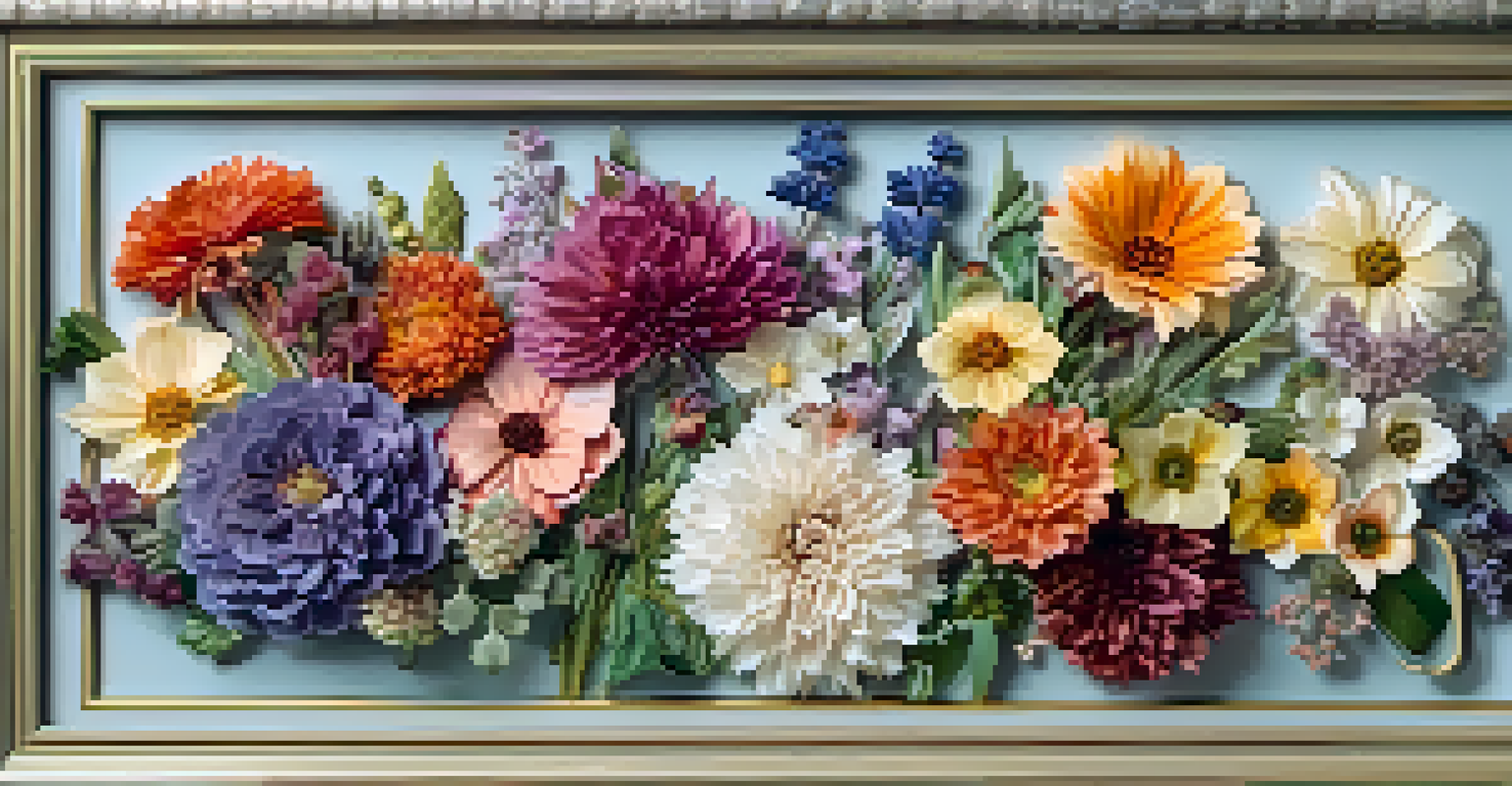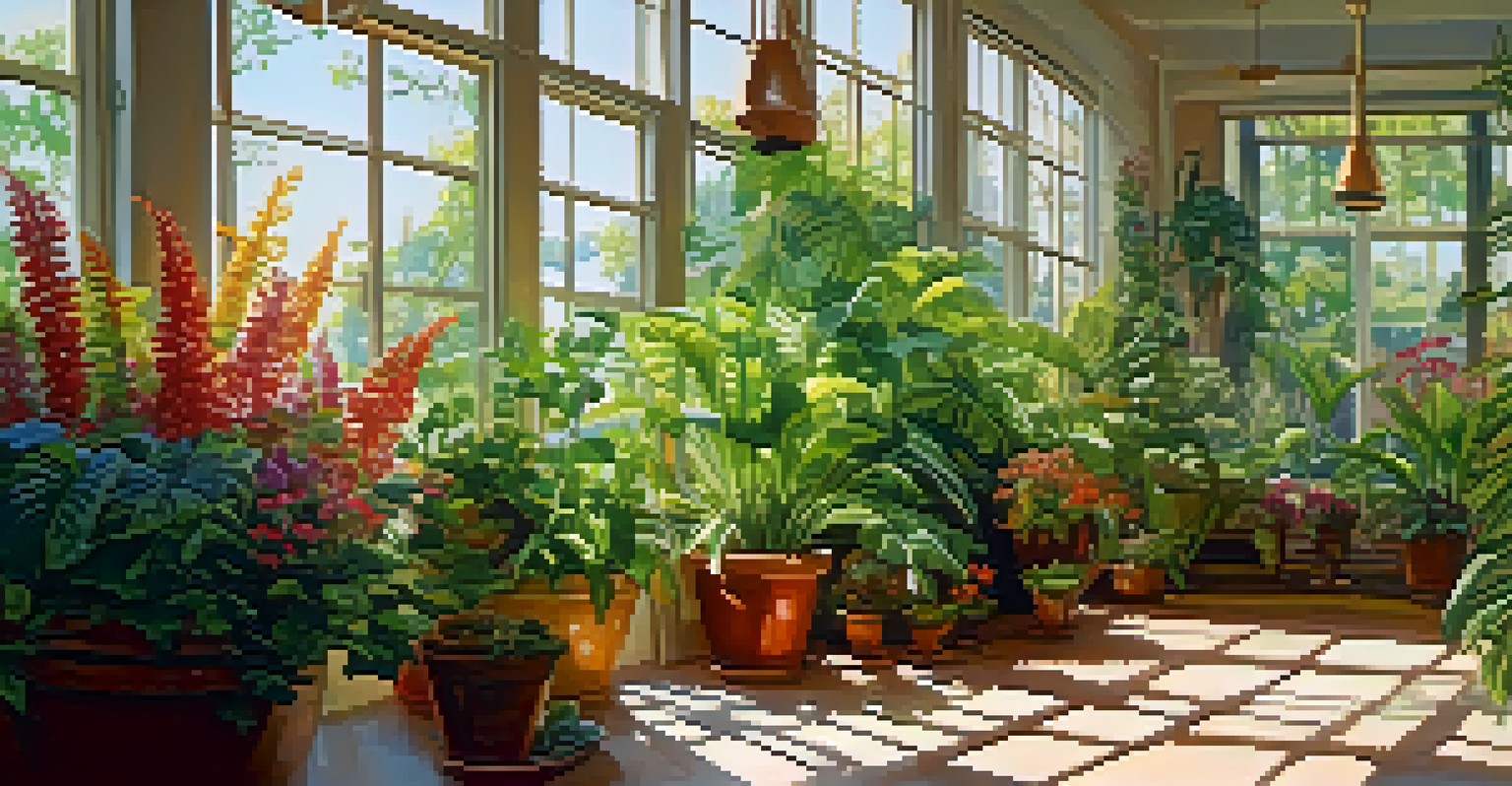Utilizing Natural Elements: Incorporating Leaves and Flowers

The Beauty of Natural Elements in Design
Natural elements like leaves and flowers bring a vibrant touch to any design. They not only enhance aesthetics but also create a connection to nature, which can elevate our mood and well-being. Imagine walking into a room adorned with fresh greenery or colorful blooms; it instantly feels more inviting and alive.
The earth laughs in flowers.
Incorporating these elements into your design can be as simple as using them in centerpieces or as accents in your decor. For instance, a beautiful arrangement of wildflowers can brighten up a dining table, while leaves can be artfully placed around a room for a touch of elegance. This approach helps merge the indoor and outdoor worlds seamlessly.
Moreover, natural elements can tell a story about sustainability and the environment. By choosing to incorporate locally sourced flowers or dried leaves, you not only support local economies but also reduce your carbon footprint. It's a win-win situation that benefits both your design and the planet.
DIY Projects: Crafting with Leaves and Flowers
Getting hands-on with leaves and flowers can lead to some exciting DIY projects. One popular idea is creating pressed flower art, where you preserve the beauty of blooms between sheets of paper. This can be turned into wall art, bookmarks, or even greeting cards, adding a personal touch to your creations.

Another fun project is leaf printing, where you can use paint to create beautiful patterns on fabric or paper. It’s a delightful way to express your creativity while celebrating the unique shapes and textures of nature. Plus, it can be a great activity to do with kids, teaching them about art and the environment at the same time.
Natural Elements Enhance Design
Incorporating leaves and flowers into your decor creates a vibrant atmosphere and fosters a connection to nature.
These DIY projects not only allow you to showcase your artistic talents but also provide a meaningful way to appreciate the beauty of nature. Each crafted piece becomes a reflection of your personal style while honoring the natural world.
Seasonal Decor: Adapting Leaves and Flowers Year-Round
One of the best aspects of using natural elements is their versatility throughout the seasons. In spring, fresh flowers can brighten up your space, while fall brings the rich colors of autumn leaves. By adapting your decor to reflect the changing seasons, you can keep your home feeling fresh and inviting all year long.
Nature does not hurry, yet everything is accomplished.
For example, consider using evergreen branches during winter for a cozy, festive atmosphere. In contrast, summer might call for vibrant sunflowers or wildflower bouquets that exude warmth and cheer. This seasonal rotation not only keeps your decor dynamic but also allows you to enjoy the beauty of nature’s cycles.
Incorporating seasonal elements can also create a sense of anticipation and celebration in your home. It’s a gentle reminder of the passage of time and the beauty that each season brings, providing a deeper connection to nature.
Floral Arrangements: Tips for Stunning Displays
Creating beautiful floral arrangements is an art, and with a few tips, you can elevate your displays. Start by choosing a variety of flowers with differing heights, shapes, and colors to add depth and interest. Think of it like composing a symphony, where each flower plays a unique role in the overall harmony.
Another essential tip is to consider the seasonality of flowers. Choosing blooms that are in season not only ensures freshness but also helps you stay within budget. Local florists often have seasonal selections that can inspire your arrangement and support your community.
DIY Projects Celebrate Nature
Engaging in hands-on projects like pressed flower art or leaf printing allows you to creatively appreciate the beauty of natural elements.
Lastly, don’t forget the importance of greenery! Leaves can add texture and frame your flowers beautifully. Incorporating a mix of foliage can enhance your arrangement, making it visually striking while complementing the vibrant colors of your blooms.
Eco-Friendly Practices: Sustainable Use of Natural Elements
As we embrace the beauty of nature, it’s crucial to practice sustainability. When using leaves and flowers, aim to source them from local growers or consider cultivating your own. This not only reduces environmental impact but also supports local economies and promotes biodiversity.
Additionally, think about how to repurpose and recycle plant materials. For instance, dried flowers can be used for potpourri or crafting, while fallen leaves can be composted to nourish your garden. Finding new uses for natural elements encourages a cycle of sustainability that benefits both you and the earth.
By incorporating these eco-friendly practices, you can enjoy the beauty of leaves and flowers while minimizing harm to the environment. It’s a simple yet profound way to respect nature and contribute to a healthier planet.
Cultural Significance of Leaves and Flowers
Leaves and flowers hold deep cultural significance in many societies around the world. For example, in Japanese culture, cherry blossoms symbolize the transient nature of life, while lotus flowers in various cultures represent purity and enlightenment. Understanding these meanings can enrich your appreciation for these natural elements.
Incorporating culturally significant flowers or leaves into your decor can serve as a conversation starter and a way to honor those traditions. Whether it’s a floral arrangement for a special occasion or a simple leaf motif in your decor, these elements can carry profound meanings.
Seasonal Decor Keeps Spaces Fresh
Adapting your decor with seasonal leaves and flowers not only adds variety but also deepens your connection to the changing cycles of nature.
This connection to culture can also inspire creativity in your design choices. By exploring the stories behind different plants, you can curate a space that reflects not just your personal style but also the rich tapestry of human experience.
Incorporating Leaves and Flowers in Everyday Life
Incorporating leaves and flowers into your daily life can be as simple as adding them to your workspace or home. A small vase of fresh flowers on your desk can boost your mood and productivity, while a few strategically placed leaves can bring a touch of nature indoors. It’s these little touches that can make a big difference in your environment.
You can also explore using natural elements in your meals. Edible flowers, for instance, can enhance salads or desserts, adding not only flavor but also visual appeal. Imagine a vibrant salad topped with nasturtiums; it’s not just food; it’s art on a plate.

By weaving leaves and flowers into your daily routine, you cultivate a deeper appreciation for nature. It encourages mindfulness and a connection to the world around you, reminding us of the beauty that exists in everyday moments.